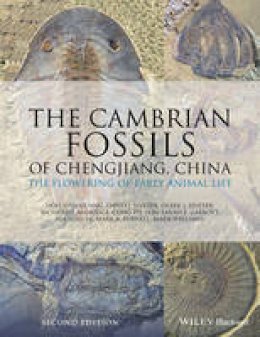
Stock image for illustration purposes only - book cover, edition or condition may vary.
The Cambrian Fossils of Chengjiang, China: The Flowering of Early Animal Life
Hou Xian-Guang
FREE Delivery in Ireland
Description for The Cambrian Fossils of Chengjiang, China: The Flowering of Early Animal Life
Hardback. The celebrated lower Cambrian Chengjiang biota of Yunnan Province, China, represents one of the most significant ever paleontological discoveries. Deposits of ancient mudstone, about 520 million years old, have yielded a spectacular variety of exquisitely preserved fossils that record the early diversification of animal life. Num Pages: 328 pages. BIC Classification: PS; RB. Category: (P) Professional & Vocational. Dimension: 279 x 216. .
The celebrated lower Cambrian Chengjiang biota of Yunnan Province, China, represents one of the most significant ever paleontological discoveries. Deposits of ancient mudstone, about 520 million years old, have yielded a spectacular variety of exquisitely preserved fossils that record the early diversification of animal life. Since the discovery of the first specimens in 1984, many thousands of fossils have been collected, exceptionally preserving not just the shells and carapaces of the animals, but also their soft tissues in fine detail. This special preservation has produced fossils of rare beauty; they are also of outstanding scientific importance as sources of evidence ... Read moreabout the origins of animal groups that have sustained global biodiversity to the present day.
Much of the scientific documentation of the Chengjiang biota is in Chinese, and the first edition of this book was the first in English to provide fossil enthusiasts with a comprehensive overview of the fauna. The second edition has been fully updated and includes a new chapter on other exceptionally preserved fossils of Cambrian age, exciting new fossil finds from Chengjiang, and a phylogenetic framework for the biota. Displaying some 250 figures of marvelous specimens, this book presents to professional and amateur paleontologists, and all those fascinated by evolutionary biology, the aesthetic and scientific quality of the Chengjiang fossils.
Show Less
Product Details
Publisher
John Wiley and Sons Ltd United States
Place of Publication
Hoboken, United Kingdom
Shipping Time
Usually ships in 7 to 11 working days
About Hou Xian-Guang
Hou Xian-guang is former Director, Key Laboratory for Palaeobiology, Yunnan University, Kunming David J. Siveter is Professor Emeritus of Paleontology, University of Leicester Derek J. Siveter is Professor Emeritus of Earth Sciences, University of Oxford Richard J. Aldridge was Professor Emeritus and F.W. Bennett Professor of Geology, University of Leicester Cong Pei-yun ... Read moreis Professor of Paleobiology, Yunnan University, Kunming Sarah E. Gabbott is Professor of Paleobiology, University of Leicester Ma Xiao-ya is Professor of Paleobiology, Yunnan University, Kunming, and the Natural History Museum, London Mark A. Purnell is Professor of Paleobiology, University of Leicester Mark Williams is Professor of Paleobiology, University of Leicester Show Less
Reviews for The Cambrian Fossils of Chengjiang, China: The Flowering of Early Animal Life
The first edition of The Cambrian fossils of Chengjiang was a �must have� book for palaeontologists. Now I am afraid you are all going to have to fork out for the second edition. After 13 years, this completely revised edition reflects the significant amount of research that has taken place over the last decade or more on the remarkable Chengjiang lagerstätte. ... Read more The fossil material of the Chengjiang lagerstätte is of course stuff to drool over and the envy of palaeontologists who have to deal with the more common forms of hard-part preservation. Over 30 species have been added to the taxonomic list, reflecting a greater understanding of the diversity and taxonomy of this biota, which now boasts a total of over 250 species. A significant number of these are still �floating around� waiting for their systematic identity card so the Chengjiang case is far from being closed. The discovery is now over 30 years old, being first found in 1984 by Hou Xian-Guang, who is still active and one of the authors of this new edition. Since the first edition was published, the site has been inscribed on the UNESCO World Heritage List (in 2012) as a �globally outstanding example of a major stage in the history of life, representing a paleobiological window of great significance�. As such, the 515-520 Ma Chengjiang biota complements Canada�s slightly younger, 505 Ma Burgess Shale biota. The latter is somewhat less diverse (c 120 known species) but has a similar ecological structure; consequently, the taxonomic similarities and differences between the two are of particular evolutionary interest and significance. This second edition of The Cambrian fossils of Chengjiang is much more than a mere update. It provides an overview of the lagerstätte and the rapidly expanding literature on all aspects of its geology, much of which is in Chinese and otherwise difficult to access. The format of the book is larger and many of the photos are even better than before. The book would be a fine present for any palaeontologist - even if you have to treat yourself! Reviewed by: Douglas Palmer "The work is authoritative and highly illustrated; the high-quality illustrations were, and are, an immensely important aspect of the work. They show just how beauti-fully preserved these soft-bodied animals are and how, with the requisite skills, this extraordinary detail can be illustrated. It is essential that this book be on every paleo-biologist�s bookshelf." - Paul Seldon, Priscum Summer 2018 "Very much like its predecessor, this book is bound to become a standard reference thanks to its very well contextualized introduction and really complete overview of the Chengjiang biota. Whether you are a natural science teacher, a specialist of the Cambrian Explosion, have an interest in palaeontology and evolution of early life, or you just like the weird diversity of forms in Cambrian animals, then this book is for you. I would recommend it to all palaeontologists and libraries, this is a must-have!" - Vincent Perrier, Paleontology Association Newsletter, July 2018 Show Less

